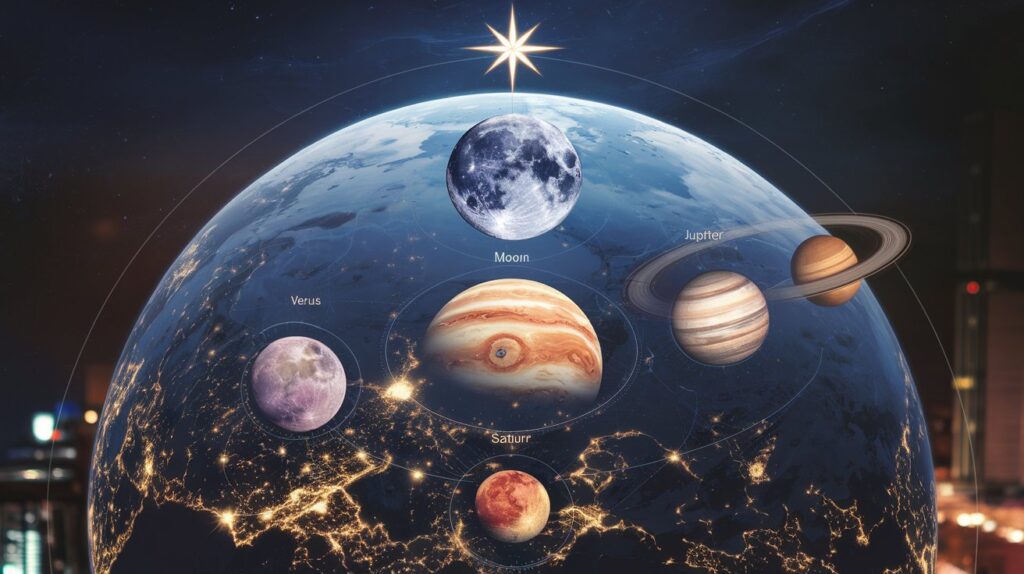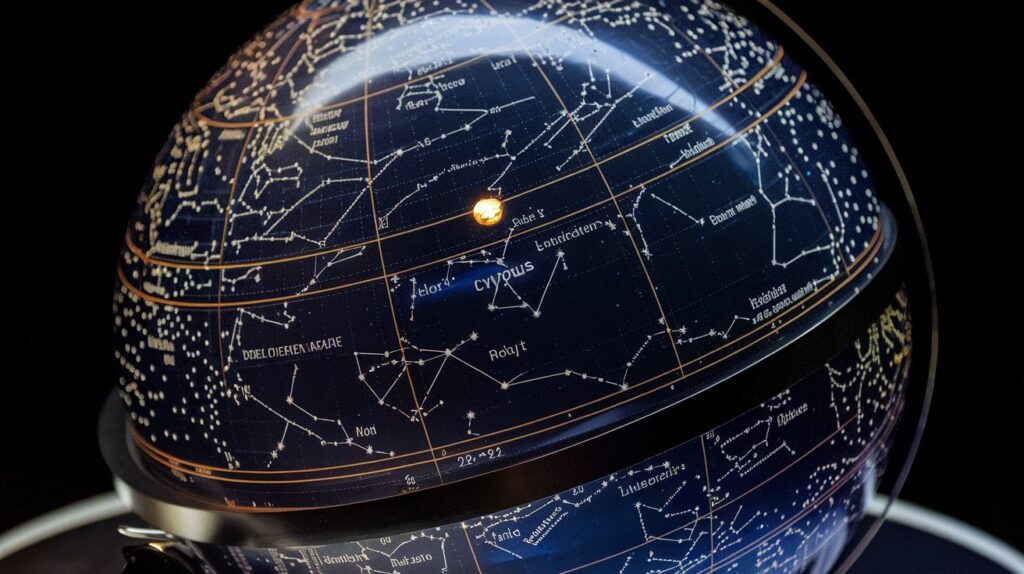
The night sky has always intrigued humanity. For centuries, civilizations have gazed upwards, making sense of the stars and planets. One of the most fundamental concepts for understanding the stars and their positions is the celestial sphere. This imaginary sphere helps observers plot celestial objects and understand their movements. This guide will walk you through the basics of the celestial sphere and how it aids in mapping the night sky.
Table of Contents
- What is the Celestial Sphere?
- Importance of the Celestial Sphere in Astronomy
- Main Components of the Celestial Sphere
- Celestial Poles
- Celestial Equator
- Ecliptic
- Zenith and Nadir
- How to Use the Celestial Sphere for Observing the Night Sky
- Coordinate Systems: Altitude-Azimuth and Equatorial
- The Daily Motion of the Celestial Sphere
- Tools for Mapping the Night Sky
- Key Takeaways
- Frequently Asked Questions (FAQs)
- Conclusion
What is the Celestial Sphere?
The celestial sphere is an imaginary sphere with an arbitrarily large radius centered on Earth. It represents a way to simplify our view of the sky, as though all celestial objects—stars, planets, and constellations—are positioned on its inner surface.
Imagine standing on a flat plain and looking up at the sky. The dome of the sky above you can be visualized as the inside of a giant sphere. You appear to be at the center of this celestial sphere, and objects like stars seem to be projected on this imaginary dome. Although these objects are at varying distances from Earth, their projection onto the sphere makes it easier to chart their positions and movements.
The celestial sphere is a practical tool because the actual distances of celestial objects are usually unknown or irrelevant for simple observations. By assuming all objects lie on this sphere, astronomers can measure their relative positions without needing to calculate their precise distance.
The celestial sphere is an imaginary sphere of arbitrarily large radius centered on Earth, onto which all celestial objects (such as stars, planets, and constellations) are projected. Although these objects are actually at different distances, the celestial sphere simplifies the study of the night sky by treating all objects as if they were equidistant from the observer.
Key concepts of the celestial sphere include:
- Celestial Poles: These are the points on the celestial sphere directly above Earth’s North and South Poles. The north celestial pole is currently very close to the star Polaris.
- Celestial Equator: This is the projection of Earth’s equator onto the celestial sphere. It divides the sky into northern and southern hemispheres.
- Horizon: The line where the sky appears to meet the Earth from a specific location.
- Ecliptic: The path that the Sun appears to follow over the course of a year as Earth orbits around it. The ecliptic is tilted by about 23.5° to the celestial equator because of the tilt of Earth’s axis.
- Right Ascension (RA) and Declination (Dec): These are the celestial equivalents of longitude and latitude on Earth, used to pinpoint the location of objects on the celestial sphere. Right ascension is measured in hours (0 to 24), while declination is measured in degrees (from +90° to -90°).
Although purely a conceptual tool, the celestial sphere is crucial in astronomy for mapping the positions of stars, tracking their movement, and understanding celestial phenomena from the perspective of Earth.
Importance of the Celestial Sphere in Astronomy
The celestial sphere allows astronomers to:
- Map the locations of celestial bodies.
- Predict the movements of stars, planets, and other objects.
- Help navigators chart their position on Earth.
- Assist amateur astronomers in finding specific stars or constellations.
The concept of the celestial sphere was developed thousands of years ago and remains a useful framework for modern astronomy. It’s not just for professionals; anyone with an interest in the night sky can benefit from learning about it.

Main Components of the Celestial Sphere
The celestial sphere has several key components that help in understanding how celestial objects move and are positioned.
Celestial Poles
At the north and south ends of the Earth’s axis of rotation, we have the north celestial pole and the south celestial pole. These points mark where Earth’s axis intersects the celestial sphere.
- North Celestial Pole: This point is directly above the Earth’s North Pole and aligns with Polaris, the North Star.
- South Celestial Pole: Directly above Earth’s South Pole, this point doesn’t have a bright star to mark it.
The celestial poles are critical because they help establish a framework for the rest of the night sky’s coordinate system.

Celestial Equator
The celestial equator is an extension of Earth’s equator onto the celestial sphere. It divides the sky into northern and southern hemispheres. Objects near the celestial equator rise in the east and set in the west, while those near the poles circle them in counterclockwise (in the north) or clockwise (in the south) directions.
Ecliptic
The ecliptic is the apparent path the Sun follows on the celestial sphere over the course of a year. This path is tilted relative to the celestial equator by about 23.5 degrees, due to the tilt of Earth’s rotational axis.
Zenith and Nadir
- Zenith: The point directly above an observer.
- Nadir: The point directly below the observer (on the opposite side of the celestial sphere).
These points are important because they change based on where you are on Earth. The zenith marks the top of the sky as seen from any specific location.
How to Use the Celestial Sphere for Observing the Night Sky
Once you understand the basic structure of the celestial sphere, you can use it to better observe the night sky. Here are some tips on how to navigate the stars:
- Locate the North Star (Polaris): If you’re in the Northern Hemisphere, the North Star is almost directly aligned with the north celestial pole. Use it as an anchor point for locating other constellations.
- Identify the Celestial Equator: The stars and constellations near the celestial equator rise and set, making them relatively easy to track throughout the night.
- Understand the Ecliptic: Since the planets in our solar system follow orbits close to the plane of the ecliptic, knowing its position in the sky helps in identifying planets and understanding why they follow similar paths as the Sun.
H3 Lists: Observing Tips
- Use a star chart or planetarium software to visualize the celestial sphere.
- Pay attention to the daily rotation of stars, which occurs because of Earth’s rotation.
- Find constellations by connecting brighter stars, often mapped onto the celestial sphere.
By learning how to plot objects on the celestial sphere, you can quickly locate stars, planets, and constellations even if you’re unfamiliar with the area you’re observing.
Coordinate Systems: Altitude-Azimuth and Equatorial
There are two primary ways to describe the location of objects on the celestial sphere: the altitude-azimuth system and the equatorial coordinate system.
Altitude-Azimuth System
This is a local system based on the observer’s position. It uses two angles to describe the position of an object:
- Altitude: How high an object is in the sky (0° at the horizon, 90° at the zenith).
- Azimuth: The direction along the horizon, measured in degrees clockwise from the north.
This system is simple and intuitive for everyday use, especially for casual stargazing.
| Coordinate | Description | Example |
|---|---|---|
| Altitude | Height above horizon | 45° |
| Azimuth | Compass direction | 180° (South) |
Equatorial Coordinate System
For more precise measurements, astronomers use the equatorial coordinate system, which remains fixed relative to the stars and uses two coordinates:
- Right Ascension (RA): Similar to longitude, it measures the object’s position eastward along the celestial equator.
- Declination (Dec): Similar to latitude, it measures the object’s position north or south of the celestial equator.
The equatorial system is more complex but remains consistent regardless of the observer’s location.
The Daily Motion of the Celestial Sphere
The stars and other objects on the celestial sphere seem to move across the sky from east to west. This apparent motion is due to Earth’s rotation. Over the course of a night, you’ll notice stars rising in the east, crossing the sky, and setting in the west.
In the Northern Hemisphere, the stars appear to rotate around the north celestial pole, with Polaris remaining relatively fixed in place. In the Southern Hemisphere, the stars rotate around the south celestial pole.
Fun Fact: The stars complete a full circle in the sky every 23 hours and 56 minutes, not exactly 24 hours. This is because of Earth’s orbit around the Sun.

Tools for Mapping the Night Sky
Many tools help map the celestial sphere and make it easier to locate stars and planets.
1. Star Charts
Printed star maps that show the positions of stars and constellations based on your location and the time of year.
2. Planetarium Software
Modern planetarium apps simulate the night sky on your device, making it easy to identify objects on the celestial sphere.
3. Telescopes with GoTo Technology
Telescopes equipped with GoTo functionality can automatically locate objects on the celestial sphere based on their coordinates.
Key Takeaways
- The celestial sphere is an imaginary dome used to project the positions of celestial objects in the night sky.
- It simplifies the process of mapping the sky by assuming all objects are at the same distance, even though they aren’t.
- The celestial equator, celestial poles, and ecliptic are essential reference points for understanding celestial movements.
- Using tools like star charts and planetarium software can enhance your ability to navigate the celestial sphere.
Important Point
| NO. | Important Points |
| 1. | About Us |
| 2. | Contact Us |
| 3. | Disclaimer |
| 4. | Privacy Policy |
FAQs of Celestial sphere
What is the celestial sphere used for?
The celestial sphere is used to map the positions of stars, planets, and other objects in the sky. It provides a framework for understanding their movement and location relative to Earth.
What is the difference between the celestial sphere and the actual sky?
The celestial sphere is an imaginary representation of the sky. While the stars and planets exist at different distances from Earth, they are projected onto the celestial sphere to make mapping easier.
Can I see the celestial sphere without a telescope?
Yes! The celestial sphere is a conceptual tool. You can
